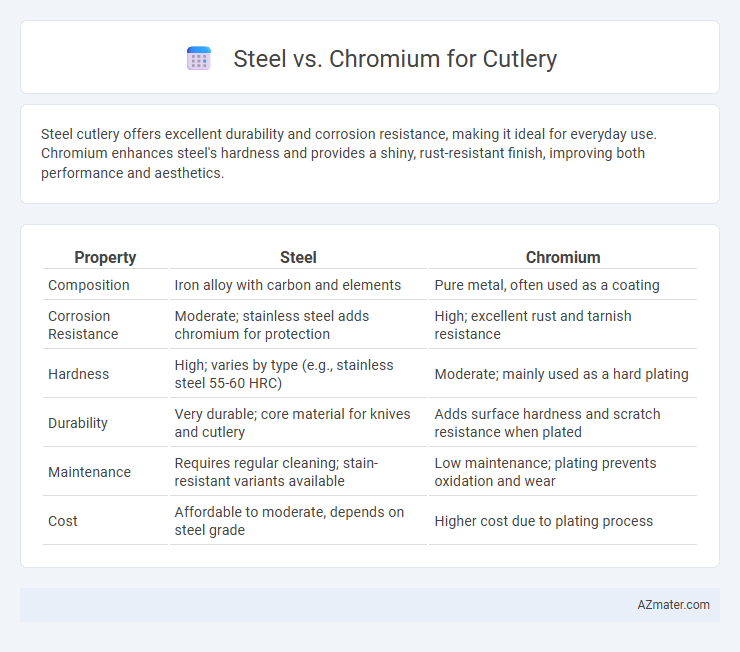Steel cutlery offers excellent durability and corrosion resistance, making it ideal for everyday use. Chromium enhances steel's hardness and provides a shiny, rust-resistant finish, improving both performance and aesthetics.
Table of Comparison
| Property | Steel | Chromium |
|---|---|---|
| Composition | Iron alloy with carbon and elements | Pure metal, often used as a coating |
| Corrosion Resistance | Moderate; stainless steel adds chromium for protection | High; excellent rust and tarnish resistance |
| Hardness | High; varies by type (e.g., stainless steel 55-60 HRC) | Moderate; mainly used as a hard plating |
| Durability | Very durable; core material for knives and cutlery | Adds surface hardness and scratch resistance when plated |
| Maintenance | Requires regular cleaning; stain-resistant variants available | Low maintenance; plating prevents oxidation and wear |
| Cost | Affordable to moderate, depends on steel grade | Higher cost due to plating process |
Introduction: Steel vs Chromium in Cutlery
Steel and chromium are essential materials in cutlery manufacturing, each contributing distinct properties that influence blade performance and durability. Steel, often carbon or stainless variants, offers strength and edge retention, while chromium enhances corrosion resistance and adds a polished finish. Selecting the optimal balance between steel hardness and chromium content ensures superior cutlery quality and longevity.
Material Composition and Properties
Steel cutlery primarily consists of iron combined with carbon, often including other elements like manganese, nickel, and chromium to enhance strength and corrosion resistance. Chromium, when alloyed at around 10-20% in stainless steel, forms a passive oxide layer that significantly improves rust resistance and durability, making it a key component in high-quality cutlery. Pure chromium is rarely used alone for cutlery due to its brittleness; instead, chromium-enriched stainless steel balances hardness, corrosion resistance, and ease of maintenance.
Hardness and Durability Comparison
Steel cutlery offers high hardness levels, typically ranging from 55 to 65 HRC (Rockwell Hardness Scale), which ensures excellent edge retention and resistance to deformation. Chromium, often alloyed in stainless steel, enhances corrosion resistance but does not independently improve hardness or durability; instead, the overall hardness depends on the steel matrix it is combined with. Durability in cutlery primarily depends on the steel grade and tempering process, with high-carbon stainless steels containing chromium providing an optimal balance of hardness and long-lasting performance.
Corrosion Resistance: Steel vs Chromium
Chromium significantly enhances the corrosion resistance of steel used in cutlery by forming a passive oxide layer that prevents rust and staining. Stainless steel with high chromium content, typically above 10.5%, offers superior durability against moisture and acidic foods compared to carbon steel, which is more prone to corrosion. This makes chromium-rich stainless steel the preferred choice for cutlery that maintains sharpness and appearance over extended use.
Edge Retention and Sharpness
Steel alloys, especially high-carbon steel, offer superior edge retention and sharpness due to their hardness and ability to be honed to a fine edge, making them ideal for cutlery requiring precision and durability. Chromium, often added to steel to form stainless steel, enhances corrosion resistance but can reduce hardness, slightly compromising edge retention compared to pure high-carbon steel. Optimal cutlery blends balance steel's sharpness and edge durability with chromium's anti-rust properties for long-lasting performance.
Maintenance and Cleaning Requirements
Steel cutlery, particularly stainless steel, offers superior resistance to rust and staining, making maintenance straightforward with simple hand washing or dishwasher use. Chromium-plated cutlery requires more careful cleaning to prevent the chrome layer from wearing off or pitting, often necessitating gentle detergents and thorough drying to avoid corrosion. Regular polishing of chromium helps maintain its shine, while steel's durability minimizes upkeep efforts over time.
Aesthetic Differences and Finishing
Steel cutlery often features a sleek, polished finish that enhances its natural metallic sheen, offering a classic and durable aesthetic appeal ideal for everyday use. Chromium plating on cutlery provides a bright, mirror-like surface resistant to tarnish and corrosion, resulting in a visually striking, high-gloss finish that maintains its shine over time. The chromium finish also allows for greater design versatility, enabling intricate patterns and textures that elevate the elegance of table settings.
Cost and Accessibility
Steel cutlery, particularly stainless steel, is more affordable and widely accessible due to its abundant availability and simpler manufacturing processes. Chromium, often used as a coating or alloying element to enhance corrosion resistance, tends to increase costs because of its higher price and more specialized application methods. Consumers seeking cost-effective and readily available cutlery typically prefer steel-based options, while chromium-enhanced products are chosen for durability at a premium price.
Environmental Impact and Sustainability
Stainless steel cutlery, primarily composed of iron, chromium, and nickel, offers higher durability and recyclability, reducing environmental waste compared to pure chromium tools that are less common and often more toxic to produce. Chromium mining and refining involve substantial energy consumption and generate hazardous byproducts, increasing its ecological footprint, whereas stainless steel manufacturing allows for greater material recovery and usage of recycled metals. Sustainable cutlery production increasingly favors stainless steel due to its longer lifespan, corrosion resistance, and efficiency in recycling processes, aligning with eco-friendly consumer demands and circular economy principles.
Conclusion: Choosing the Right Material for Cutlery
Steel offers durability and corrosion resistance essential for everyday cutlery, while chromium enhances hardness and provides a polished, rust-resistant finish. Selecting the right material depends on balancing factors such as maintenance requirements, aesthetic preferences, and intended usage frequency. High-carbon stainless steel with adequate chromium content remains the optimal choice for long-lasting, sharp, and easy-to-maintain cutlery.

Infographic: Steel vs Chromium for Cutlery
 azmater.com
azmater.com